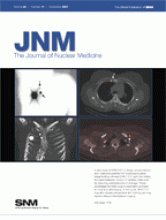REPLY: In their letter to the editor, Eisner and Patterson make 3 criticisms that they call “major limitations” to our report on attenuation–emission misregistration in cardiac PET/CT (1), as follows: First, the frequency of attenuation–emission artifacts in PET/CT is similar using slow helical CT during breathing, using a rotating rod during breathing, and using cine CT during breathing, all without manual shifting for final optimal coregistration. In our report, this “baseline” frequency of misregistration was corrected by manual coregistration of attenuation and emission scans for the rotating rod (2) and cine CT attenuation data (1). Second, in their protocol, 1 of 3 sequential fast helical CT scans were acquired during breathing without shifting to achieve coregistration. Artifacts were small or, in 85% of cases, absent, and only more severe artifacts were corrected by shift software. Third, the radiation dose for PET/CT is too high and needs to be reduced.
Our paper in The Journal of Nuclear Medicine validated a PET/CT protocol that eliminates all misregistration artifacts, thereby providing a definitive, quantitative, standalone noninvasive guide for the management of coronary artery disease. To our knowledge, the paper was the first large, systematic clinical report defining and solving this problem in PET/CT and having significant implications.
The vehemence of their terming their criticisms as “major limitations” is puzzling for several reasons. Basically, Eisner and Patterson agree that attenuation–emission misregistration is a real problem in cardiac PET, a problem not widely addressed clinically until our first reports in The Journal of Nuclear Medicine (1,2). Contrary to the emphasis in their letter, the frequency of misregistration artifacts with cine CT attenuation correction (1) without manual shifting should be and is similar to that with the rotating rod (2) because both acquire attenuation data that are averaged over the breathing cycle. The data would be inconsistent otherwise. However, breathing during slow helical CT distorts the attenuation data such that manual shifting to achieve coregistration fails to eliminate the corresponding artifacts, as our data show (1). Despite averaging of attenuation correction during breathing using either a rotating rod or cine CT, misregistration still occurs, requiring manual shifting to optimize coregistration in all patients.
A careful paper from Bacharach's laboratory (3) on quantitative PET demonstrates that the degree of attenuation varies substantially with respiration even when cardiac borders are coregistered. Therefore, structures of time-changing attenuation vary in intensity with breathing during emission scans, and this variation can be reproduced only by averaging the attenuation measurements obtained during breathing. Two recent papers (4,5) and a thoughtful editorial (6) published after submission of our reports (1,2) also confirmed the importance of performing attenuation correction on PET/CT to account for varying attenuation with breathing during emission scans.
It is not apparent how multiple-CT fast helical scans acquired during breathing, as proposed by Eisner and Patterson, address this documented variation in attenuation during breathing even if 1 of 3 fast helical CT scans coregisters with the emission images. Paradoxically, their statement indicates that 2 of the 3 fast helical CT scans during breathing cause misregistration, consistent with our data, but that a random 1 of 3 fast CT scans provides correct coregistration in 85% of cases but not all patients. In our cine CT approach, we acquire data at any projection angle 20 times during 2–3 respiratory cycles for effective averaging of time-changing attenuation for all CT slice locations. However, the multiple fast helical CT scans may not produce a predicable result because they can sample moving objects only in a snapshot of time that fails to account for time-changing attenuation.
Two references are quoted in support of their criticisms of our paper and in support of their approach: an abstract from 2004 (7) and another from 2007 (8). Neither of these abstracts was published as a peer-reviewed paper, and no quantitative data have been reported. Finally, their technique of acquiring 3 fast helical CT scans in hopes that one will fit the emission data—a technique that by their own admission fails in 15% of cases—does not seem a good solution from our viewpoint of using cardiac PET as a definitive, standalone guide to the management of coronary artery disease, particularly in the absence of published quantitative clinical data.
Some CT scanners are limited in performing cine CT, as reported by Low et al. (9). In an example cine scan obtained on a 4-slice Siemens VZ, each 0.5-s acquisition is followed by 0.25 s of dead time; a maximum of 7 couch positions (1 cm per couch position) can be programmed; and reprogramming for additional coverage requires approximately 2 min. If the scanner used by Eisner and Patterson is similarly limited in doing cine CT, they need to develop other approaches that address the problem effectively with quantitative published data rather than attacking a rational good solution that works.
We notice an inconsistency between the 0.7-mGy absorbed dose in their letter and the 0.7-mSv effective dose reported in an abstract (8) by the same group. Eisner and Patterson should address this discrepancy before comparing radiation doses between different CT techniques. However, we agree that radiation exposure is excessive in PET/CT, particularly compared with the relatively negligible exposure from rotating rod attenuation. The estimated risk of cancer from excessive use of CT angiograms causes substantial concern (10), particularly with its limited resolution and technical factors that fail to separate 23% diameter stenosis from 77% diameter stenosis of coronary arteries (11). Cardiac PET needs to avoid this radiation risk. Therefore, rotating rod attenuation for cardiac PET remains an excellent option of diagnostic value comparable to PET/CT. We have also developed protocols for substantially reducing radiation exposure from cine PET/CT. These protocols have been applied to large numbers of patients, and objective quantitative data prove their quantitative accuracy. We anticipate that Eisner and Patterson will provide a definitive clinical study with quantitative data on their proposed approach to attenuation correction in PET/CT that is not available to date.
Footnotes
-
COPYRIGHT © 2007 by the Society of Nuclear Medicine, Inc.







